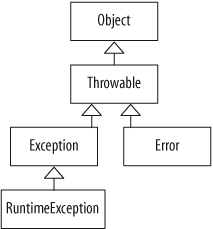Chapter 7. Exception Handling
An exception is an anomalous condition that alters or interrupts the flow of execution. Java provides built-in exception handling to deal with such conditions. Exception handling should not be part of normal program flow.
The Exception Hierarchy
As shown in Figure 7-1, all exceptions and
errors inherit from the class Throwable, which inherits
from the class Object.

Checked/Unchecked Exceptions and Errors
Exceptions and errors fall into three categories: checked exceptions, unchecked exceptions, and errors.
Checked Exceptions
Checked exceptions are checked by the compiler at compile time.
Methods that throw a checked exception must indicate so in the method declaration using the
throwsclause. This must continue all the way up the calling stack until the exception is handled.All checked exceptions must be explicitly caught with a
catchblock.Checked exceptions include exceptions of the type
Exception, and all classes that are subtypes ofException, except forRuntimeExceptionand the subtypes ofRuntimeException.
The following is an example of a method that throws a checked exception:
// Method declaration that throws
// an IOException
void readFile(String filename)
throws IOException {
...
}Unchecked Exceptions
The compiler does not check unchecked exceptions at compile time.
Unchecked exceptions occur during runtime ...
Get Java Pocket Guide now with the O’Reilly learning platform.
O’Reilly members experience books, live events, courses curated by job role, and more from O’Reilly and nearly 200 top publishers.

